Apple iPhone 6 Plus vs LG G3
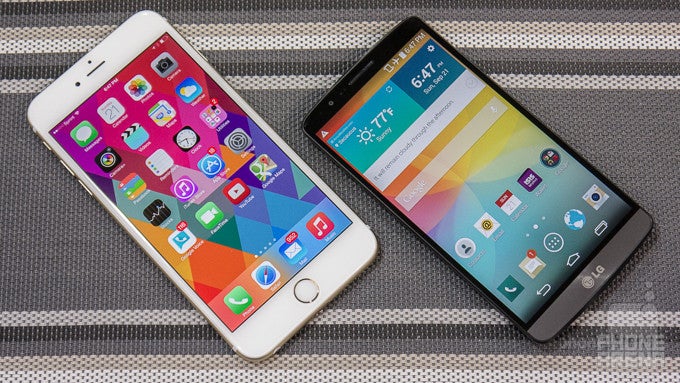
Introduction
Thanks to an extensive rumor phase preceding the release of the new iPhones, we knew that Apple is likely on path to embracing a bigger screen for its devices. The 4.7-inch iPhone 6, for example, felt almost certain at multiple points during that time window. But the rumored 5.5-inch iPhone 6 – what we came to know as the iPhone 6 Plus – now that didn't feel like anything close to a sure thing. Could Apple really break away from its narrative so drastically in just one generation? As we now know, the answer is: yes, it can, and it did.
There's a lot about the iPhone 6 Plus to love – a massive, phablet category-worthy display, a speedy new processor, an excellent camera with optical image stabilization (OIS), and a hearty battery, all packed within a slender, 0.28 in (7.1 mm) body. But you know who else checks all those off the list, as well? LG's latest G3 flagship, which has an even more detailed, Quad HD display, a great Snapdragon 801 processor, a 3000 mAh cell, and an impressive, 13-megapixel camera with OIS. In other words, one would think that it all comes down to a good, old-fashioned Android versus iOS bout more than anything else. Is that all there is to it, though? Let's find out!
Design
Despite their identically-sized 5.5” screens, the iPhone 6 Plus is a significantly larger device than the G3.
When it comes to style, few can make a case against Apple's taste. The iPhone 6 Plus definitely contains very large doses of the Apple design DNA, but what we have with the company's first phablet is an evolution over previous generations. Perhaps the most noticeable difference is seen at the sides – those are now nicely-rounded (instead of rectangular) and the back plate has seen a different approach that is not entirely Apple-like. By that we mean those two horizontal stripes on the bottom and top of the iPhone 6 Plus's rear, where the antennas reside, and, of course, the protruding camera. In any case, we're glad to see that the iPhone 6 Plus retains the glass-and-aluminum exterior that has become characteristic of the iPhone, and it definitely justifies the expectations of a high-end, premium smartphone.
Turning to the LG G3, we're looking at the pinnacle of both the company's design and engineering capabilities. This is the most attractive LG device to date, and we obviously like it a lot. Unlike its predecessor, which sported straighter lines on all sides, the G3's top and bottom lines are arced, giving the phone a familiar, but somewhat unique look. Speaking of unique, the rear of the G3 is anything but typical, for it houses the volume rocker and power key, along with an opening for a novel laser beam that is used by the camera to focus pretty quickly. Unfortunately, despite the decidedly-metallic look of the G3 (especially the dark gray model), we're still talking about a polycarbonate plastic shell – it's just a really, really good imitation.
Putting the two devices side-by-side may be a little shocker for some – despite their identically-sized 5.5” screens, the iPhone 6 Plus is a significantly larger device than the G3. The reason behind this discrepancy in physical footprint is simple: LG continues to outdo itself when it comes to fitting large screens in extremely-thin frames, all the while Apple's large, Touch ID home button at the front still takes quite a bit of space. In result, the iPhone 6 Plus is taller, wider, and heavier. On the plus side, it's considerably slimmer – 0.28 in (7.1 mm) versus 0.35 in (8.9 mm).
All of the above has very concrete consequences for ergonomics – or the overall experience handling either device – and the winner here is fairly clear: the G3. For the iPhone 6 Plus, you'll mostly need two hands to operate it efficiently. The same is not necessarily true with the G3, whose more compact body often allows you to go for it with just one hand, but that doesn't mean it's a small device by any means.
Thankfully, Apple has moved the power key to the right, within a thumb's distance, while the volume rocker and the silencer switch are both on the left. All of these are made out of aluminum and are really among the very best when it comes to travel time and tactile feedback. In comparison, the rear-placed, plastic keys on the G3 take some getting used to, and while excellent on the whole, can't quite compare with what the iPhone 6 Plus has going on.
Display
The iPhone 6 Plus scores better outdoor visibility while the G3 touts its high resolution.
The 5.5-incher on the 6 Plus is of the IPS LCD type, has a resolution of 1080 x 1920 pixels (or an excellent density of 401 ppi), and an ion-strengthened glass (alike to Gorilla Glass) with an oleophobic coating, which does a very decent job keeping nasty smudges from overtaking the panel. The LG G3 has a somewhat similar panel – a 5.5-incher, again of the IPS LCD type, but we're looking at a considerably higher resolution of 1440 x 2560 pixels, or a density of an astounding 534 ppi, which is more than your eyes can perceive, actually. Unlike the iPhone 6 Plus, LG has gone for Corning's Gorilla Glass 3 for protection, and has, of course, also applied a comparable oleophobic coating.
So far, so good, but what about the qualities of those panels? Starting with the iPhone 6 Plus, we're looking at a very bright screen, capable of cranking up the brightness to up to 574 nits, which is excellent. The minimum brightness, at 4 nits, is also great, and will allow for a comfortable viewing in dark environments. As for the LG G3, the maximum brightness the phone could achieve in our tests was 450 nits, while the minimum was 9 nits (which is a bit too high). The screen on the G3 can be seen when outdoors, but direct sunlight will pose some difficulty, even though it won't render it unusable.
Moving onto color accuracy, our color error measurements show Delta E RGBMCY of 4.38 for the iPhone 6 Plus. This suggests an average adherence, or, in other words, the display is not perfect, but still pretty accurate on the whole. In terms of color reproduction, LG has gone for an overstated calibration, meaning that hues on average are more saturated for the majority of intensity levels than optimal. Thankfully, this isn't overdone, so colors are punchy, but not ridiculous (color error is 3.60). In terms of color temperature – the optimal is 6500 K, and at 7300 K, the screen on the 6 Plus has a slight bluish overcast, and that skews color reproduction slightly. LG G3 is slightly better in this aspect, with a temperature of 7100 K.
Interface and functionality
With iOS 8, the emphasis is on simplicity, while the LG-themed Android on the G3 comes with numerous extra features
iOS and Android are pretty different at their core – pretty much everybody knows that. Especially when you're talking about skinned Android, as is the case with the G3. While LG aims to deliver an extremely feature-rich experience for G3 users, this isn't at all alike to Apple, which has a far lighter approach, devoid of anything but the essentials – the rest is usually delegated to the wealth of apps available through the iTunes store.
The above distinction has pretty massive consequences when it comes to the look of the two UIs – the iPhone 6 Plus has a simple layout, and is easier overall to follow and get early on. Depending on your needs, however, that's obviously not necessarily a desirable effect, as this does come at the expense of control over the way the interface looks and the overall function of your device. Let's drill down into both of them separately.
Starting with the 6 Plus, the new Apple phablet is touting the newest version of the platform, iOS 8, out of the box. iOS 8 actually corrodes the idea that Apple likes to keep its operating system completely closed-off, and introduces some major changes, including the ability to choose a different, third-party software keyboard, and even grants developers access to the Touch ID fingerprint sensor for use with their apps. iOS 8 also is the first iteration in the history of the OS to allow for widgets – even though these are limited to the notification bar only.
As for the Android 4.4 KitKat-touting LG G3, we're looking at several neat features, including a double tap to wake/sleep functionality and a Dual Window mode that allows you to run two apps simultaneously side-by-side. The G3 doesn't sport a fingerprint sensor, but it does come with KnockCode, which only allows the user to unlock the screen by performing a pre-set pattern of taps. Also handy, and on the topic of privacy, come the Content Lock and Kill Switch features – the former allows you to hide sensitive data, while the latter lets you remotely lock and wipe your device in the event of theft.
Processor and memory
The 6 Plus is a notably better performer, specifically when talking about the smoothness of operating and navigating the interface
Like in previous years, Apple is once again using its latest generation of the iPhone to showcase a new processor of its own design. Based on ARMv8 architecture, the new 64-bit A8 chip has two cores running at 1.4GHz and makes use of a very potent PowerVR GX6650 GPU that supposedly delivers up to 50% better performance when compared with the GPU found in the iPhone 5s. Looking at the LG G3, we've got a known entity – a Qualcomm Snapdragon 801 MSM8974-AC chipset, the highest edition of the SD801, with four Krait 400 cores, clocked at 2.5GHz, and a speedy Adreno 330 GPU.
Judging from the above, one would assume that the LG G3 has a massive and very clear edge in terms of processing power, especially since it comes with 3GB of LPDDR3 RAM (versus 1GB for the iPhone 6 Plus), but the reality is not that simple.
Indeed, the 6 Plus is actually a notably better performer, specifically when talking about the smoothness of operating and navigating the interface – in comparison the G3 is a bit laggy and slow. The reasons for that are likely two: one, the LG G3's custom layout is just heavier, and two – the phone has to push a significantly higher number of pixels with everything it does. That's correct, the Quad HD resolution on the G3 puts considerable load on the Snapdragon 801 chip, and this also extends to graphically-intensive apps and games, which, on average, are rendered at a lower frame rate.
As for built-in storage, you've got several options with the iPhone 6 P lus – 16GB, 64GB, and 128GB. That last option is a first with a major manufacturer, and should suffice even for the most obsessed of multimedia junkies looking to make out the most of the 5.5-inch screen. In comparison, the LG G3 is available with 32GB of internal memory, though you can expand that through a microSD card for up to 128GB more. That's a cheaper option, but it's also inferior in terms of reliability and read/write speeds.
Internet and connectivity
Built-into iOS 8 and the iPhone 6 Plus, you'll find the Safari browser – a lightweight, snappy performer that is, however, devoid of pretty much any extras. According to synthetic benchmarks, it's also quicker to render pages than what you have available on the G3. Speaking of LG's flagship, we've got Google's Chrome and LG's own browser available, so you have some choice. The former is speedy, but not very intriguing in terms of the feature set it brings to the table. LG's own browser, while slightly better-equipped to meet that demand is, nevertheless, still not very feature-filled, though it does offer perks like full-page screenshots.
Moving onto connectivity, the highlight of the iPhone 6 Plus is its wide support for FDD LTE bands – there are 15 of those, which is a whole lot more than what the G3 offers, and that's good news for iPhone users if they plan on using LTE abroad. Both phones have their maximum theoretical download speeds capped at 150Mbps, or Category 4 LTE, and will both also settle on a 4G HSDPA+ network if their provider's LTE coverage falls short.
The two devices also have GPS with Glonass support, Bluetooth 4.0, and Wi-Fi 802.11 ac. NFC is also available with both, though the iPhone 6 Plus will likely have a better use for the chip once the Apple Pay service for mobile payments launches in October. One omission on Apple side's is an IR blaster, available with the LG G3, for use with home electronics.
Camera
Two similarly great cameras with fast focus systems and OIS
Like in previous years, Apple has yet again refused to jump onto the megapixel bandwagon and start an arms race with the Android world. To that end, the shooter found on board is an 8-megapixel iSight camera complemented by a five-element, f/2.2 lens, a two-tone LED flash, and optical image stabilization. Focus speed is improved thanks to a phase-detection system – special focus pixels in the sensor. At the front, we're looking at a 1.2-megapixel selfie snapper, which should suffice for your occasional video calls.
Looking at the LG G3 next, we've got a 13-megapixel sensor with a narrower, f/2.4 lens and a dual tone LED flash. The G3's rear camera is also optically-stabilized, and features the company's second-gen OIS+ tech that, in our experience, is pretty good at compensating for shake during video recording. Focus is aided by the laser beam on the back. Turning the G3 around, we're met with a 2.1-megapixel shooter at the front, which, again, should serve your selfie and video call needs well.
In terms of their interfaces, you'll find that both devices offer a pretty simple one, even when you venture into the settings menus. This translates into a hassle-free operation in landscape and portrait modes, and the overall experience is focused on getting a shot fast and easy. Both devices also have support for automatic HDR and panoramas, though the G3 stands out with extras like Magic focus (allows you to change the focus point post-capture or set it to infinite) and Dual mode (fires a shot with both the front and rear cameras simultaneously). Where the iPhone 6 Plus wins out is the ability to lock focus and manually adjust exposure right from the viewfinder – two options that are not available with the LG G3.
When shooting outdoors during the day, the two cameras are a somewhat alike in their behavior – both introduce a slightly warm tint, but not one that is overpowering enough to warrant a serious critique. Where they differ is the relative saturation of the colors they produce – the LG G3 is prone to overstating those, though – again – we're talking about small deviations. That said, the iPhone 6 Plus does provide the slightly more realistic results, and we especially like the dynamics of its shots on the whole.
As for snaps inside, when light is not as abundant, we're starting to notice a more clear split in the performance of the two. On the whole, when not making use of its flash, the LG G3 produces shots that are noticeably brighter, which helps with discerning details even in darker corners of the composition, but the shots are, overall, very warm – enough to skew color reproduction in the iPhone 6 Plus' favor. A reversal is seen when the flash does go off, however – the LG G3's dual tone flash causes snaps that are not as pleasantly-warm as with the iPhone 6. On the other hand, the iPhone 6 Plus' flash isn't as powerful, so scenes end up a tad darker than with the LG G3.
Moving onto video capture, both devices can shoot 1080p clips at 30 framers per seconds (FPS), though the iPhone 6 Plus can also do 1080p at 60 FPS and even capture 720p clips at 120 and 240 FPS. There's also an extra Time Lapse mode, which condenses lengthy footage into a short clip for an artistic effect. Where the iPhone 6 Plus falls short, though, is the lack of extremely-high-resolution, 4K UHD video – a saving grace for the G3's camcorder.
On the whole, clips with both devices are above average, though the G3 does produce a tad too contrasty clips with overstated colors. Footage is also, on the whole, quite warm, regardless of whether you're shooting at 1080p or 4K. As for the iPhone 6 Plus – its footage is also on the warm side, but the effect is not as visible, and it tends to produce more natural tones. The optical image stabilization works great on both, so panning during capture is silky-smooth.
Multimedia
These 5.5-inch screens are made for watching video, but the G3 comes with the better player
With both devices featuring large, 5.5-inch screens, there's no questioning their role as an on-the-go multimedia hub. Also helpful with that are the high resolutions of both panels, though the LG G3's is obviously more detailed, even though content for such insane pixel counts is extremely rare.
Looking at the two devices' respective video players, we've gotta hand it to LG – its take on the format is ripe with extras, and includes controls for playback speed and aspect ratio, subtitles, and you can even re-size and put the clip on top of whatever it is you're doing. In comparison, the iPhone 6's video player is very simplistic in nature – it basically does what you'd expect it to do: playback video content. The same distinction can't be said to exist once the G3's and the iPhone 6's music players are involved – the two are fairly straightforward, but attractive.
Speaking of video and audio reproduction, we have to note that the speaker on the iPhone 6 Plus is less loud in comparison, but also offers a higher degree of sound fidelity. We're also split on the placement of both device's respective loudspeakers – the iPhone 6 Plus' one resides on the bottom bezel, which means it won't get muffled when laying the device flat on a surface, but you may obstruct the opening when playing games in landscape mode, while the LG G3's rear-placed speaker means exactly the opposite: slightly muffled sound when laying flat, but no problem when gaming in landscape mode.
Lastly, opening up the galleries side-by-side, the two are down to the point. The iPhone 6's, this time around, however, is more flexible, and allows you to split photos by the date and place they were taken – a neat feature if you want to organize them into albums.
Call quality
It wasn't easy to produce a clear winner when it came to call quality, for both devices have punchy earpieces that are sufficiently loud and clear, and their microphones also transmit voices to the other side without any significant distortions or artifacts.
Battery life
Apple has fitted a healthy, 2915 mAh cell of the non-removable type inside the iPhone 6 Plus' body, and that one should last even heavier users a day. Our battery life test indicates that the average user will be able to squeeze 6 hours and 32 minutes out of the phablet, if using it non-stop. Looking at the LG G3, the result is quite similar – 6 hours and 14 minutes out of the removable 3000 mAh cell found within.
As for official numbers, the iPhone 6 Plus is rated good for 24 hours of talk time on a 3G network and 16 days of stand-by on a 2G one. As for the LG G3, the equivalent ratings read 23 hours of talk time on a 3G network and a little under 23 days of stand-by on 2G.
In conclusion, neither of these two phablets can claim to have a record-setting battery endurance, but they're still above average on the whole. Still, we can't say that we weren't wishing for more.
Conclusion
Picking between the iPhone 6 Plus and the LG G3 may feel like an overwhelming task – after all, the two trade blows left and right. With Apple's first phablet, you're getting a more stylish, but much bulkier device, with a less-detailed screen that is nevertheless perfectly fine. The 6 Plus is also a considerably better performer in day-to-day tasks and apps execution, and its camera is, on the whole, a notch better than what LG has going on.
The G3, on the other hand, can almost pass for a large smartphone, not a phablet, thanks to its compact dimensions, and its Quad HD screen is a beauty if you can find content suited for it. Despite that crazy pixel density, the LG G3 also essentially ties with the iPhone 6 Plus in terms of battery life – an important stalemate for it, as that could have easily decided the face-off.
If all of the above still isn't enough for you to make a pick, then the fact that we're looking at two very different operating systems might – with iOS 8, the emphasis is on simplicity, while the LG-themed Android version on the G3 comes with numerous extra features. Perhaps most importantly, the G3 is also now a significantly cheaper that the 6 Plus – and that, more than anything, ought to narrow it down enough for you to make a decision.

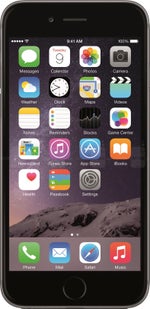
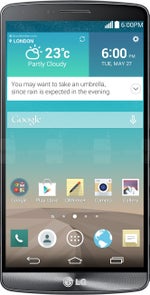








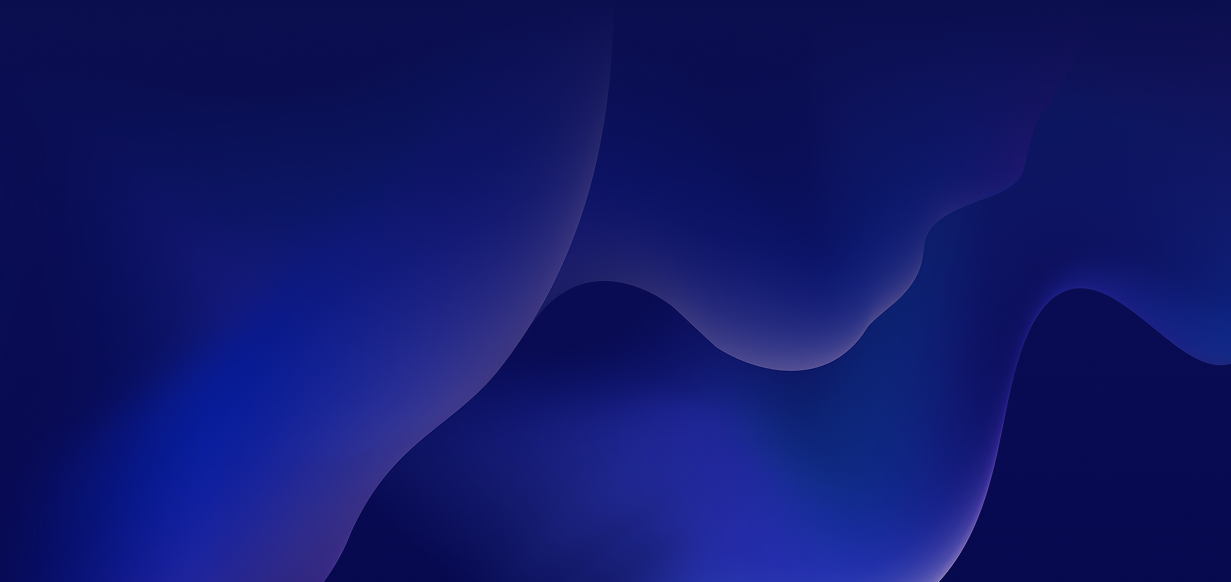

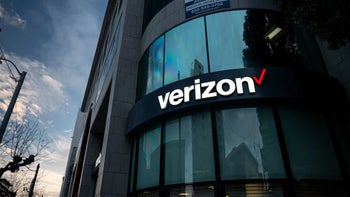
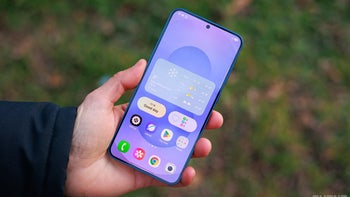
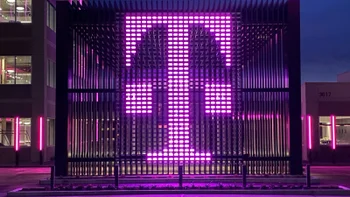
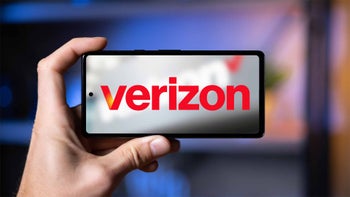
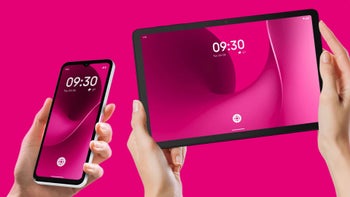
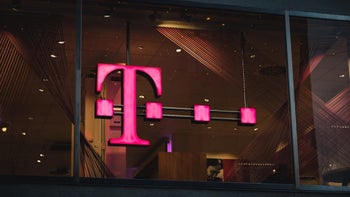

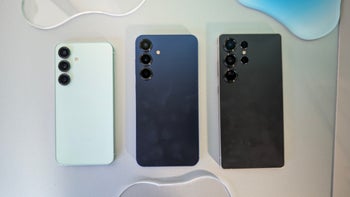
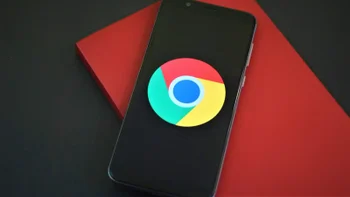
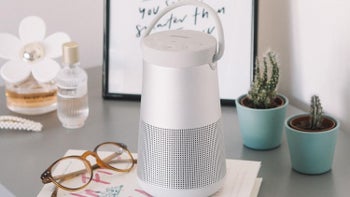
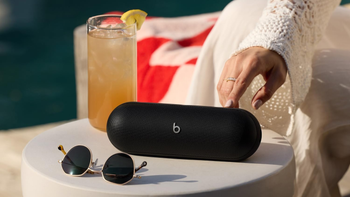
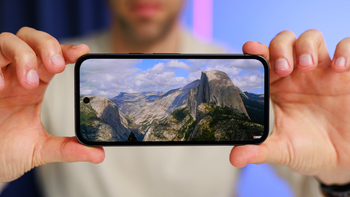
Things that are NOT allowed:
To help keep our community safe and free from spam, we apply temporary limits to newly created accounts: